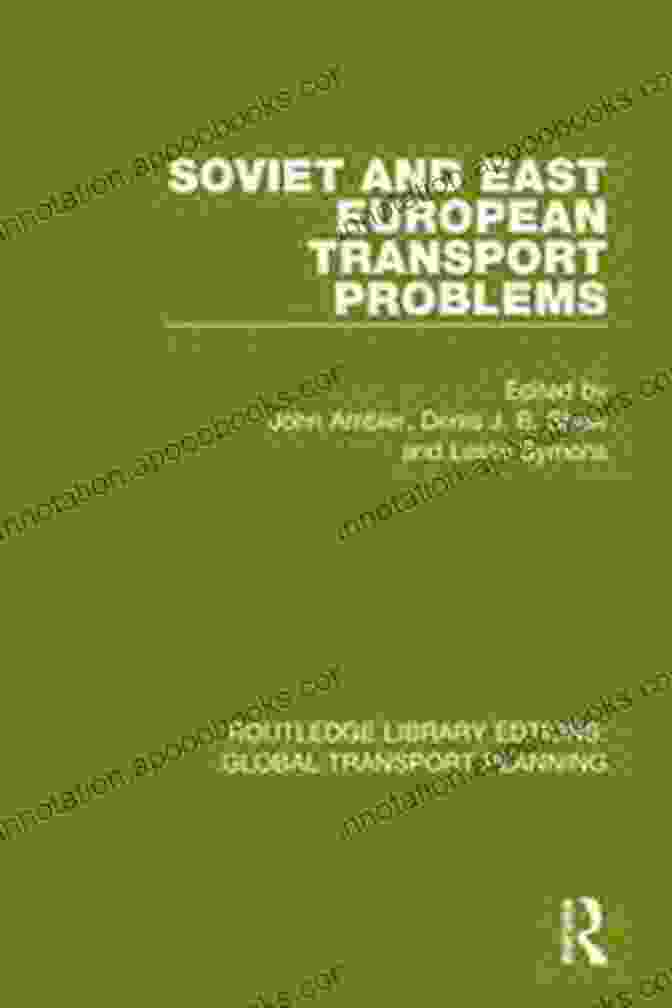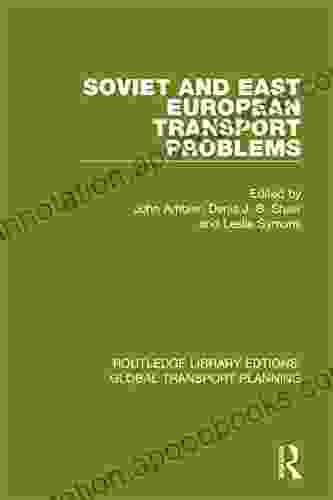Soviet and East European Transport Problems: Uncovering the Challenges and Opportunities of the Past


Transportation has always played a crucial role in the development and prosperity of nations. For the Soviet Union and its Eastern European allies, transportation was particularly critical as it facilitated the movement of goods, people, and ideas across vast and diverse regions. However, the Soviet and East European transport systems faced numerous challenges, which significantly impacted their economic and social development. This article delves into the intricate web of transportation problems faced by the Soviet and East European bloc, shedding light on their causes, consequences, and potential solutions.
4.7 out of 5
| Language | : | English |
| File size | : | 1055 KB |
| Text-to-Speech | : | Enabled |
| Enhanced typesetting | : | Enabled |
| Word Wise | : | Enabled |
| Screen Reader | : | Supported |
| Print length | : | 302 pages |
| Paperback | : | 70 pages |
| Item Weight | : | 5.6 ounces |
| Dimensions | : | 6 x 0.18 x 9 inches |
Historical Context
The Soviet Union and its Eastern European allies emerged from World War II with devastated economies and infrastructure. The war had severely damaged transportation networks, industrial facilities, and urban centers. The post-war period witnessed a massive reconstruction effort, with the Soviet Union prioritizing heavy industry and military production. Transportation, however, received less attention, leading to chronic underinvestment in infrastructure and equipment.
Structural Challenges
The Soviet and East European economies were characterized by centralized planning, with the state playing a dominant role in resource allocation. This centralized approach often led to inefficiencies and distortions in the transportation sector. The absence of market mechanisms hampered innovation and competition, resulting in a lack of incentives for technological advancements and improved service quality.
Moreover, the Soviet and East European economies were heavily dependent on the production and export of raw materials. This reliance on bulk commodities necessitated the development of infrastructure specifically designed for transporting heavy loads. Consequently, the transportation systems were not well-suited for the movement of more diverse and value-added goods, which were becoming increasingly important in the global economy.
Technological Limitations
The Soviet Union and its allies lagged behind Western countries in terms of transportation technology. The automotive industry, for instance, was dominated by state-owned enterprises that produced vehicles that were outdated, inefficient, and unreliable. The lack of access to advanced technologies and foreign investment further hindered the development of modern transportation systems.
The railway system, once the backbone of Soviet and East European transportation, also faced challenges. The railways were primarily used for hauling heavy freight, but their capacity and efficiency were limited by outdated equipment, poor track maintenance, and inefficient signaling systems.
Environmental Concerns
Transportation played a significant role in environmental degradation in the Soviet and East European bloc. The heavy reliance on fossil fuels for transportation led to air and water pollution. The disposal of hazardous materials from the transportation sector also posed environmental challenges.
Social Impacts
The transportation problems experienced by the Soviet and East European bloc had a profound impact on the lives of ordinary citizens. Inefficient public transportation systems made it difficult for people to move around within cities and between regions. This limited access to education, healthcare, and employment opportunities, particularly for residents of rural areas.
The lack of reliable and affordable transportation also hindered the development of tourism and cultural exchange. The isolation of the Soviet and East European bloc from the West further exacerbated these problems.
Reform and Transformation
The collapse of the Soviet Union in 1991 brought about a period of economic and political transformation in Eastern Europe. The transition to market economies and democratic governments led to a re-evaluation of the transportation sector.
Many of the structural and technological challenges faced by the Soviet and East European transport systems persisted after the collapse of the Soviet Union. However, the transition to market economies created new opportunities for investment and innovation. Foreign companies entered the transportation market, bringing with them advanced technologies and management practices.
Privatization and deregulation measures introduced competition into the transportation sector, leading to improved efficiency and service quality. The adoption of market-based pricing mechanisms helped to align supply and demand, reducing the chronic shortages and inefficiencies that had plagued the Soviet and East European transport systems.
The transportation problems faced by the Soviet and East European bloc were complex and multifaceted. They stemmed from a combination of historical, structural, technological, and environmental factors. The transition to market economies and democratic governments after the collapse of the Soviet Union brought about a period of reform and transformation in the transportation sector. While many of the challenges persisted, the of market mechanisms, foreign investment, and advanced technologies has led to significant improvements in efficiency, service quality, and environmental sustainability.
The legacy of the Soviet and East European transport problems continues to shape the development of transportation systems in the region today. Understanding the challenges and lessons learned from the past is essential for policymakers and transportation planners who seek to create sustainable and efficient transportation systems for the future.
References
* Hanson, P. (2005). Transportation in the Soviet Union: A History of Soviet Transportation from 1917 to 1991. Routledge. * Kupchan, C. A. (2011). Eastern Europe in Transition: From Integration to Differentiation. Routledge. * Ofer, A. (1992). Transportation in Eastern Europe and the Soviet Union: Retrospect and Prospect. International Economic Review, 33(2),301-318. * Sagers, M. J. (1994). Soviet and East European Transportation Problems: Current and Future. Routledge. * White, S. (1998). Politics and Transportation in the Soviet Union. Ashgate.
4.7 out of 5
| Language | : | English |
| File size | : | 1055 KB |
| Text-to-Speech | : | Enabled |
| Enhanced typesetting | : | Enabled |
| Word Wise | : | Enabled |
| Screen Reader | : | Supported |
| Print length | : | 302 pages |
| Paperback | : | 70 pages |
| Item Weight | : | 5.6 ounces |
| Dimensions | : | 6 x 0.18 x 9 inches |
Do you want to contribute by writing guest posts on this blog?
Please contact us and send us a resume of previous articles that you have written.
 Book
Book Novel
Novel Page
Page Chapter
Chapter Text
Text Story
Story Genre
Genre Reader
Reader Library
Library Paperback
Paperback E-book
E-book Magazine
Magazine Newspaper
Newspaper Paragraph
Paragraph Sentence
Sentence Bookmark
Bookmark Shelf
Shelf Glossary
Glossary Bibliography
Bibliography Foreword
Foreword Preface
Preface Synopsis
Synopsis Annotation
Annotation Footnote
Footnote Manuscript
Manuscript Scroll
Scroll Codex
Codex Tome
Tome Bestseller
Bestseller Classics
Classics Library card
Library card Narrative
Narrative Biography
Biography Autobiography
Autobiography Memoir
Memoir Reference
Reference Encyclopedia
Encyclopedia Christine Kersey
Christine Kersey J Kearston
J Kearston James N Hamilton
James N Hamilton Emilia Finn
Emilia Finn Chloe Hanks
Chloe Hanks Ciaran Waples
Ciaran Waples Christopher Lorenz
Christopher Lorenz Louise Chipley Slavicek
Louise Chipley Slavicek Christine Lohmeier
Christine Lohmeier Karen Robiscoe
Karen Robiscoe Clare R Kilbane
Clare R Kilbane Chris Seiter
Chris Seiter Cheyenne Mccray
Cheyenne Mccray Charlotte Schwartz
Charlotte Schwartz Chielozona Eze
Chielozona Eze Myra Wood
Myra Wood Ciara Graves
Ciara Graves Chris W Surprenant
Chris W Surprenant Robeson Taj Frazier
Robeson Taj Frazier Daniel Hall
Daniel Hall
Light bulbAdvertise smarter! Our strategic ad space ensures maximum exposure. Reserve your spot today!

 Jonathan Hayes300 Years of History: The Enduring Legacy of Jack and Doris Smothers in Texas
Jonathan Hayes300 Years of History: The Enduring Legacy of Jack and Doris Smothers in Texas Joshua ReedFollow ·17.6k
Joshua ReedFollow ·17.6k Walt WhitmanFollow ·2.1k
Walt WhitmanFollow ·2.1k Levi PowellFollow ·3.1k
Levi PowellFollow ·3.1k Mason PowellFollow ·4.4k
Mason PowellFollow ·4.4k Tom HayesFollow ·12.8k
Tom HayesFollow ·12.8k Robert HeinleinFollow ·15.3k
Robert HeinleinFollow ·15.3k Ted SimmonsFollow ·3.1k
Ted SimmonsFollow ·3.1k Braeden HayesFollow ·9.3k
Braeden HayesFollow ·9.3k

 Kevin Turner
Kevin TurnerDive into the Enchanting World of "Crazy Like Fox": A...
Prepare yourself for a literary adventure...

 Ralph Waldo Emerson
Ralph Waldo EmersonUnlock the Elegance of Daffodil Lace: An Immersive Guide...
: A Tapestry of Delicate...

 Gerald Parker
Gerald ParkerNever Lose An Argument Again: 20 Powerful Techniques From...
Are you tired of losing...

 Xavier Bell
Xavier BellSeven Animal Insertions Filet Crochet Pattern: Embark on...
Welcome to the captivating...

 Eugene Powell
Eugene PowellMagomago in TDS Magomago 12: An Unforgettable Adventure...
Step into the Enchanting World of...

 Marvin Hayes
Marvin HayesSoft Felting Needle Holder Excellence In Reborn Artistry
Unveiling the Secrets of the...
4.7 out of 5
| Language | : | English |
| File size | : | 1055 KB |
| Text-to-Speech | : | Enabled |
| Enhanced typesetting | : | Enabled |
| Word Wise | : | Enabled |
| Screen Reader | : | Supported |
| Print length | : | 302 pages |
| Paperback | : | 70 pages |
| Item Weight | : | 5.6 ounces |
| Dimensions | : | 6 x 0.18 x 9 inches |










